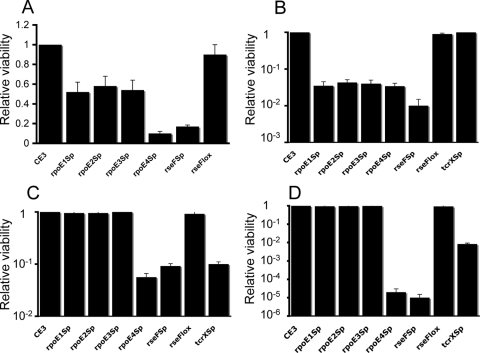FIG. 1.
Roles of the tcrX and rpoE genes of R. etli in responses to oxidative and osmotic stresses. The viabilities of the CFNXE1Sp (rpoE1 Sp), CFNXE2Sp (rpoE2 Sp), CFNXE3Sp (rpoE3 Sp), CFNXE4Sp (rpoE4 Sp), CFNXΔ3274Sp (rseF Sp), CFNXΔ3274lox (rseF lox), and CFNXTXSp (tcrX Sp) strains relative to that of wild-type strain CE3 in the presence of H2O2 (A), methyl viologen (B), NaCl (C), and sucrose (D) are expressed as the surviving fractions of the mutant strain populations divided by the surviving fraction of the CE3 population. The surviving fraction was calculated as the number of viable cells after treatment with or in the presence of the compound, divided by the number of viable cells in the absence of stress. The surviving fractions of the CE3 populations in the presence of H2O2, methyl viologen, NaCl, and sucrose were 0.02, 0.92, 0.93, and 0.93, respectively. The data presented are the averages of results from at least three independent experiments. For H2O2 treatment, exponential-phase cultures (OD600, ∼0.3) were incubated with 5 mM H2O2 for 45 min. For the other treatments, the bacteria were grown in PY medium containing methyl viologen (40 μM), NaCl (80 mM), or sucrose (15%, wt/vol).

